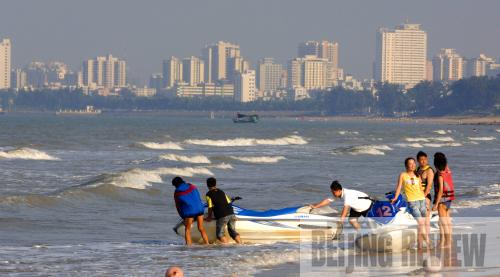|
 |
|
EXCITING CRADLE: Children enjoy a thrill ride at the Shijingshan Entertainment Park in Beijing on October 6 (LI JUNDONG) |
Nearly one year after the bottoming-out economy caused potential sightseers to cancel their travel plans, tourists are once again reaching for their cameras and suitcases as China's tourism market seems to be recovering sooner than expected. Train tickets became more difficult to acquire, and airlines began to discontinue special discounts in the run-up to the National Day holiday, the busiest travel week of the year.
As early as September, some of the most popular domestic tour routes were sold out. This year Beijing, Sanya, Xiamen, Guilin and Qingdao ranked among the hottest travel destinations, according to data from Ctrip.com, a major online travel company headquartered in Shanghai.
 |
|
BEACH FUN: Tourists flocked to Haikou, capital city of south China's Hainan Province, during the National Day holiday (ZHAO YINGQUAN) |
The tourism boom comes as a surprise, even among industry insiders. "The market turns out to be much better than we had expected," said Dun Jidong, General Manager of the China Travel Service Head Office Co. Ltd., one of the country's top three travel agencies.
"Given the looming economic downturn and the impact of the A/H1N1 virus, we were less optimistic," he said. "But now, the market is burning hot, and we regret not having booked more seats on our flights."
In early September, the China Tourism Academy (CTA) predicted that the number of domestic tourists during the National Day holiday would increase 13 percent year on year to reach 200 million. The number, considered a wild exaggeration then, is turning out to be an obvious miscalculation as the China National Tourism Administration (CNTA) estimates the number of travelers to be much greater than the anticipated 200 million.
In addition, railway operators have stepped up vigorous efforts to meet the growing tourist traffic demand. From September 28 to October 8, a total of 33 newly added temporary passenger trains were put into operation to bridge popular tourist cities, including Zhangjiajie of Hunan Province, Shenzhen of Guangdong Province and Kunming of Yunnan Province.
The Ministry of Railways and local operators have additionally taken measures to strengthen its passenger services, including a 24-hour hotline for inquiries and complaints. A number of back-up trains were also prepared for emergency purposes.
Government incentives
The domestic travel market is bound to maintain a rapid growth, though reverberations from the financial crisis is yet to vanish, Dai Bin, Deputy Director of the CTA, told Beijing Review. The growth has been largely attributable to powerful government incentives that sparked Chinese tourists' interest, he said.
This year, relevant government departments have reinforced promotional efforts while implementing a number of tourism programs across the country that have proven to be effective in fueling the travel rush, he added.
The CNTA, for example, recently announced a joint effort with the Ministry of Culture to facilitate the promotion of the cultural tourism business. The two departments will hold an annual cultural tourism festival and seek to entice private investors into the travel market, according to the announcement.
Local governments are also highly motivated to promote the tourism sector and reap the economic benefits that an increased flow of tourists will bring. A dozen provinces, including Hainan and Guangdong, have allocated resources to drastically improve their natural landscapes and recreational facilities to attract tourists.
The northwest Xinjiang Uygur Autono-mous Region, for instance, promoted travel deals that gave a 50-percent discount to room charges of star hotels and ticket prices of scenic spots in the region. In addition, the local government launched a massive promotional campaign around the country.
The wide array of promotional efforts are paying off as the local tourism market tries to shake off a decrease in tourist numbers caused by the July 5 riot. According to the local government, the number of visitors to the Kanas Lake, Tianchi Lake and Grape Valley in the region has recovered to 40 percent that of the same period last year.
In Shanghai, tourism promotion has experienced a noticeable increase as well. The Shanghai Tourism Administrative Commission has teamed up with 28 domestic banks to issue tour cards, which give travelers discounts at local hotels and scenic spots. To further polish its appeal to inbound tourists, the city plans to issue the cards in the United States, Europe, South Korea and Japan next year.
The massive campaign to make traveling more attractive is not unwarranted, as the tourism sector produces a multiplier effect to bolster the broader economy, said Dai Bin. The travel fever has injected steam into a string of relevant industries, such as catering, hotels and transportation, and will continue to do so, he added.
Tourism revenues nationwide from January to June this year added up to 497.9 billion yuan ($72.8 billion), representing an increase of 10.6 percent year on year. This was widely believed to be a remarkable contributor to widening domestic demands as retail sales spiked.
The switch of focus to domestic demand comes at a crucial time, as the country is precipitating a strategic shift away from exports to rely more on domestic consumption for economic growth and further providing a rare chance for the tourism industry to take off, said Dai.
The 4-trillion-yuan ($586 billion) stimulus package will be a catalyst for the private consumer market, a long-anticipated opportunity for the travel industry to prosper, he added.
Future travel
The ominous shadow of the A/H1N1 flu virus will almost certainly put a damper on the Chinese travel business, but its impact will be less severe than the SARS (severe acute respiratory syndrome) in 2003, said a recent report released by the CTA. If the virus comes under control in a short period of time, the market is likely to stage a sharp run-up in the fourth quarter, it said.
According to report estimates, the number of domestic tourists this year will increase by a robust 10 percent to 1.9 billion persons, and total revenues will gain 8 percent to reach 950 billion yuan ($139 billion). The number of outbound tourists will stand at around 47 million, a dismal growth of 3 percent from the previous year.
Meanwhile, the number of inbound tourists is expected to drop 5 percent to 124 million person-times, with total revenues sliding 5 percent to $35 billion according to the report.
But signs of an initial recovery have been emerging. The number of inbound tourists in August increased 3.06 percent to 11.09 million person-times, reversing a 15-month downward streak, according to the CNTA.
The domestic travel market has great potential to grow as the economy stabilizes and the Chinese people improve their standard of living, said Dai. China has already become the fourth largest inbound tourism market in the world and the largest outbound travel market in Asia, he added.
What deserves constant attention is the fact that some structural changes are taking place in the industry, noted Dai. Domestic tours will gain a larger market share, and the short-distance leisure travel of urban residents, in particular, will see a long-anticipated boom.
Equally promising is high-end business travel, which is expected to gain popularity in the coming years, he added.
Dai predicted that tourism, if it can maintain torrid growth, is likely to become a pillar industry that will help drive up the national economy. The government also aims to propel the industry to log total revenues of more than 3.6 trillion yuan ($526.7 billion), around 11 percent of the gross domestic product.
Travel Figures
The combined road and waterway passenger traffic nationwide totaled more than 500 million trips on October 1-8. Road trips increased 6.8 percent year on year to 488 million while the waterway trips went up 4.1 percent to 7.8 million.
The number of plane flights grew 11.3 percent year on year to 42,173 during the holiday, and air trips increased 7.8 percent to 5.29 million.
The number of mainlanders traveling to Hong Kong, Macao and Taiwan increased over 50 percent from a year earlier.
Beijing received 70 percent more inbound tourists than a year ago during the holiday.
(Source: Ministry of Transport)
| 